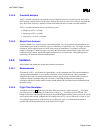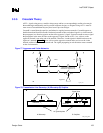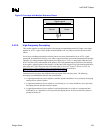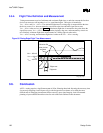
Intel
®
820E Chipset
R
Design Guide 155
3.4. More Details and Insight
3.4.1. Textbook Timing Equations
The “textbook” equations used to calculate the propagation rate of a PCB are the basis for spreadsheet
calculations of timing margin based on the component parameters. These equations are as follows:
Equation 9. Intrinsic Impedance
Z
0
= (L
0
/ C
0
)
½
(Ω)
Equation 10. Stripline Intrinsic Propagation Speed
S
0
_
STRIPLINE
= 1.017 × ε
r
½
(ns/ft)
Equation 11. Microstrip Intrinsic Propagation Speed
S
0
_
MICROSTRIP
= 1.017 × (0.475 × ε
r
+ 0.67)
½
(ns/ft)
Equation 12. Effective Propagation Speed
S
EFF
= S
0
× (1 + (C
D
/ C
0
))
½
(ns/ft)
Equation 13. Effective Impedance
Z
EFF
= Z
0
/ (1 + (C
D
/ C
0
))
½
(Ω)
Equation 14. Distributed Trace Capacitance
C
0
= S
0
/ Z
0
(pF/ft)
Equation 15. Distributed Trace Inductance
L
0
= 12 × Z
0
× S
0
(nH/ft)
The symbols for Equations 8–15 are as follows:
• S
0
Speed (in ns/ft) of the signal on an unloaded PCB. This is referred to as the board propagation
constant.
• S
0
_
MICROSTRIP
, S
0
_
STRIPLINE
Speed (in ns/ft) of the signal on an unloaded microstrip or stripline
trace on the PCB
• Z
0
Intrinsic impedance (in Ω) of the line. This is a function of the dielectric constant (ε
r
), line
width, line height, and line space from the plane(s). The equations for Z
0
are not included in this
document. For these equations, see the
MECL System Design Handbook by William R. Blood, Jr.
• C
0
Distributed trace capacitance of the network (in pF/ft)
• L
0
Distributed trace inductance of the network (in nH/ft)
• C
D
Sum of the capacitance of all devices and stubs, divided by the length of the network’s trunk,
not including the portion connecting the end agents to the termination resistors (in pF/ft)
• S
EFF
and Z
EFF
Effective propagation constant and impedance of the PCB when the board is
“loaded” with the components


















